 | 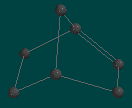 |
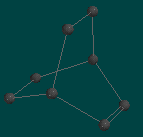 | 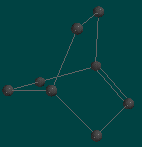 |
 | 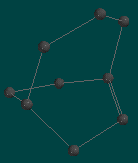 |
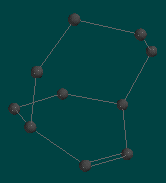 | 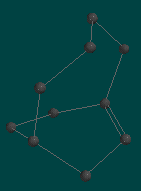 |
When a group of carbon atoms are attached in a cyclic manner to a cyclohexene ring, the point of attachment on the cyclohexene ring is called a bridgehead carbon. The geometry of this atom can have a great effect on the strain, and therefore the energy of, the entire molecule. If a double bond must be formed on the cyclohexene ring, Bredt's rule states that it will not be formed at the bridgehead position because of the added strain that gives. In this study, you will investigate the relative energies of such molecules and attempt to give empirical evidence for Bredt's rule.
Construct the structures shown below and optimize their geometries at the AM1 level. Notice that all the structures on the left follow Bredt's rule, while the molecules on the right are called anti-Bredt structures. For the purposes of this study, the primary ring is the cyclohexene ring and the secondary ring is the group of carbons attached to the primary ring. Notice that the graphics below have the hydrogens hidden. The builder will attach them automatically, and you can hide them if you wish.
 |  |
 |  |
 |  |
 |  |
Record the heat of formation for each molecule. Heat of formation is the amount of energy produced or consumed in the reaction to produce the molecule. If this measure is negative, then the molecule may be formed spontaneously. If the heat of formation is positive, the molecule will not be formed spontaneously, and will probably not be formed at all. For two possible geometries of a molecule, if one shape has a heat of formation which is one kcal/mol lower than the other, it will be ten times more abundant. So, even a small difference in the heat of formation can cause one geometry to be produced instead of another.
Compare and discuss your results with your classmates. How large a difference is there between the heats of formation for each pair of molecules? Which structures are more stable (ie, will actually be produced by the reaction)? How does the difference in heats of formation change with the size of the secondary ring?
If time permits, check the geometries of each pair. Are the bond lengths distorted at all? The length of a C-C bond in a planar molecule is 1.515 A, and the length of a C=C bond in a planar molecule is 1.34 A. Which type of structure shows more strain (ones that obey or disobey Bredt's rule)?
Generate HOMO surfaces for the geometries above. Do the HOMOs confirm your conjecture about the distortion of the molecules? If so, how?
Generate electrostatic potential surfaces for the geometries above. Recall that the elpot can indicate potential sites for reactions to occur. Is either set of structures more reactive (higher elpot)? If so, at what location? How does this relate to Bredt's rule?
Do you think it would be possible for some anti-Bredt structures to be stable enough to be formed? How large would the secondary ring have to be to absorb the strain? Check your conjecture by constructing the forms which obey and disobey Bredt's rule. Demonstrate that the difference in heats of formation is no larger than 1kcal/mol.
[Glossary][CompChem Main Page][HTML Labs]
 The Shodor
Education Foundation, Inc.
The Shodor
Education Foundation, Inc.